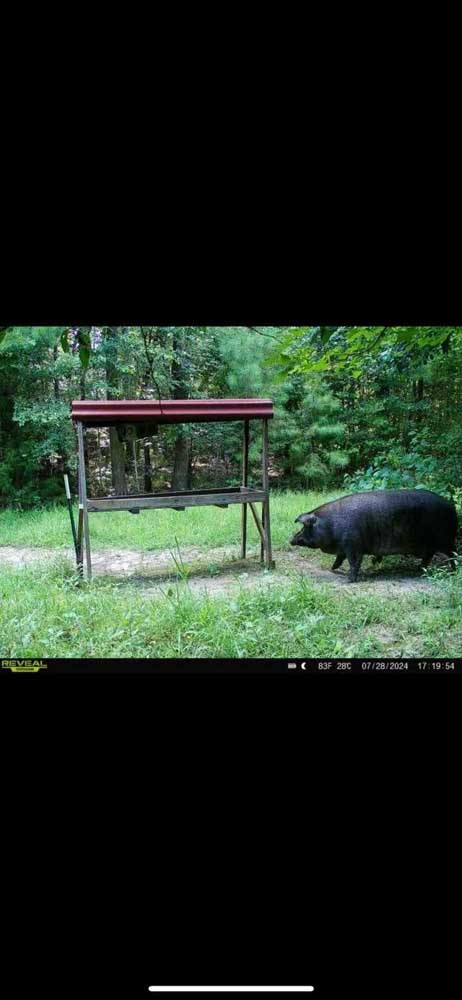Quarter Ton: Anderson County had bigger pig problem than most
Published 10:30 pm Friday, October 18, 2024

- Dane Tibbets is accustomed to having wild pigs around his feeders and food plots on his lease in Anderson County, but what he is not used to are pigs that tip the scales at over 500 pounds. (Jim Hocker/Contributed)
Hunters across Texas are accustomed to having their deer corn stolen by wild pigs. The hooved pests are usually the first to arrive just before or seconds after a feeder goes off. The only thing that seems to make them late is that they start at another feeder.
With an estimated 3 million (that number seems low) roaming around the state they are also a problem to farmers, homeowners and even golf courses where they root looking for food. And while hunters bemoan the loss of deer corn and food plots, it pales in comparison to the tens of millions in dollar losses the pigs cause others.
Trending
Wild pigs are found across Texas with the lone exception of El Paso County, but it seems that East Texas is ground-zero for the pest. Dane Tibbets is accustomed to them on his hunting club near Maydelle in Anderson County.
“We have killed a hundred of them already this year,” Tibbets said of efforts on the 1,500-acre paper company lease.
Tibbets, who lives on Lake Palestine, has two stand locations on the lease, and has learned in the six years he has been on it that he must fence his feeders or lose his corn and protein to the pigs.
“I have feeders and troughs. I have pens around them so they can’t get in. I do have one feeder in front of my pens that I leave open so they can come in and I can get a shot at the pigs,” Tibbets said.
While most of the pigs Tibbets and others on the lease see are the average 75- to 150-pound animals, he has taken a couple that weighed 200 to 250 pounders in the past.
This summer, however, the hunter got game camera pictures of a pair of black pigs that were larger than the average wild pig. In fact, much larger.
Trending
He first saw the pigs in July, but they go more active after he planted a fall food plot adjacent to one of his blinds. The stand sits in a bottom alongside a creek and streamside management zone.
Tibbets was not the first to get a shot at the pigs. That honor went to his son-in-law and grandson, who dropped one of the big pigs before he got a chance to hunt them. They realized the pig was big, but bottoming out a set of scales that went to 325 pounds the question remained how big.
That left the second pig.
“I have pictures of her on the hoof. She looked pretty big there. She looked like a hippo,” Tibbets said.
After the first pig was brought in, another member showed up with a set of scales that could handle weights up to a thousand pounds.
“I planted a food plot, mostly peas, and she was in there eating them up. She didn’t have a clue I was in the stand. She was walking right toward me at 75 yards away.There was no ground shrinkage,” Tibbets said.
With the pig on the ground, Tibbets could only hook it to a truck and drag it back to camp where it was chained to a bucket on a tractor to be lifted and weighed.
“We have a meat pole hanging between two trees, but I was afraid to use that,” the hunter said.
It was probably a good thing because the sow tipped the scales at 504 pounds and measured 5-foot-10 from nose to tail.
Tibbets and other club members who had seen the early pictures speculated that instead of a wild-bred pig these were possibly domestic pigs that had somehow ended up in the wild. They based their opinion on a shorter snout and floppier ears than wild pigs.
Experts have also said it is unlikely for a wild pig to reach those kinds of weights because of the effort it takes them to survive foraging.
“But she was wild. She was feral,” Tibbets said.
The big pig was not aged, but pigs in the wild can live up to 8 years old, although they seldom do.
Pigs were first domesticated in Europe and Asia between 8,000 and 10,000 years ago. They first arrived in North America in 1539 in Florida. They arrived in Texas three years later.
Wildlife experts believe Texas’ wild pigs are a combination of domestic breeds and originated from the custom of turning pigs loose in the fall to forage on acorns.
Hunting is not considered the best method for controlling wild pig numbers because hunters can usually only take one, maybe two, at a time. Large traps are considered a better choice. There are studies being done by Texas A&M and others looking at a warfarin-based toxicant as a solution. The key is to develop an application that impacts only the pigs and no other species that utilize the same food source.
Contact Steve at outdoor@tylerpaper.com







